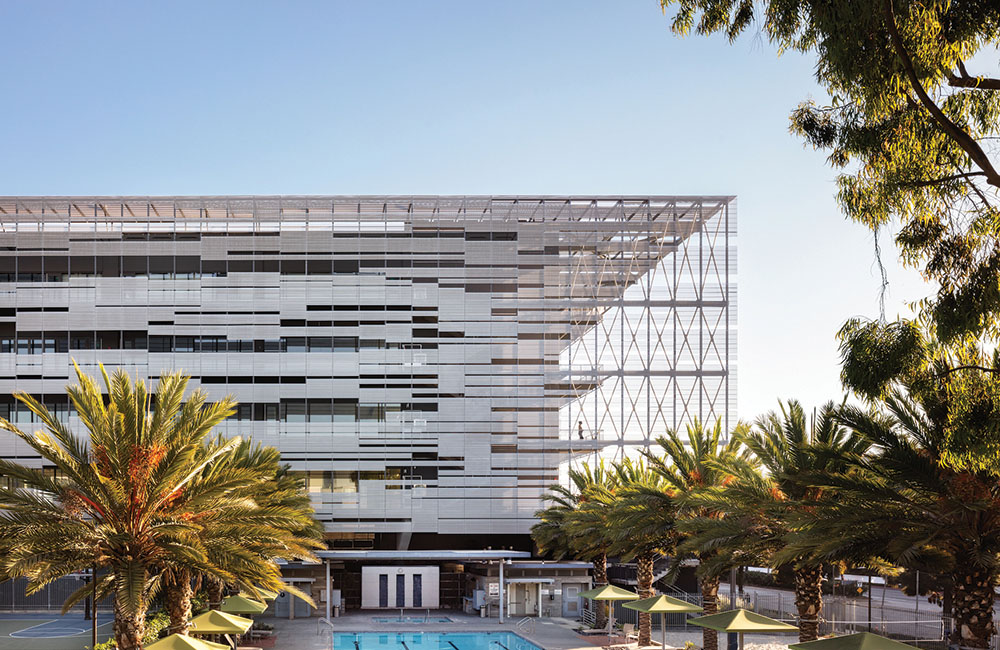
The three-building Water’s Edge campus in Playa Vista, located near the L.A. offices of Facebook and Google.
Courtesy of Cbre

As L.A.’s commercial real estate market recovers from the massive blow of COVID, some areas are flourishing while others are stuck in a two-year slump,. “It’s somewhat of a tale of two cities, depending on which market we’re talking about,” says Jodie Poirier, executive managing director at Colliers.
Notes Bill Bloodgood, executive managing director at Newmark, “It is bouncing back much faster in the markets that we consider the primary tech- and entertainment-driven markets.” This is good news for established and emerging creative hubs like Culver City, West L.A., the South Bay and the Arts District. It’s bad news for more traditional business districts like downtown’s core and dated office spaces that look like “a law firm in the ’80s or ’90s,” in the words of Jaclyn Ward, managing director at JLL.
Overall, the Greater Los Angeles area’s commercial arena is lagging behind the rest of the country because of stricter COVID regulations, with 25 percent of office space vacant, according to Colliers’ 2022 first-quarter report. While employees are coming back to work, they are returning fewer days a week, decreasing the need for floor space. “We are seeing companies do more with less space,” Bloodgood says.

The three-building Water’s Edge campus in Playa Vista, located near the L.A. offices of Facebook and Google.
Courtesy of Cbre
The pandemic also has accelerated pre-COVID trends, with employers putting a premium on fostering a comfortable, creative environment for their employees. High-rise, cubicle-heavy offices are out. Brick and timber low-rise buildings with ample natural light, garden space, high ceilings, ease of ingress and egress and amenities including gyms and dog parks are in.
A prime example of this new style is Hackman Capital Partners’ 30-acre 888 Douglas St. campus in El Segundo, a converted former aerospace plant with soaring 50-foot ceilings and skylights. Another is Water’s Edge in Playa Vista, where Nike has taken over a building on a campus that includes an Olympic-sized pool.
“I think that more and more companies want to use their office space as a competitive advantage in hiring and creating a culture and an environment where their employees want to come back to the office,” says Jeff Pion, vice chairman at CBRE.
Ward sees a battle of amenities brewing amid companies competing for employees. “We’ve got the great resignation on our hands,” she says. “We have a very tight labor market and we’ve got these changing workplace dynamics. Big companies are all fighting for a lot of the same talent.”
Culver City, home to Amazon Studios and Warner Bros. Discovery, continues to be the hottest entertainment hub in L.A. “It has an abundance of very high-quality real estate in a more contemporary high-rise type of environment and, additionally, a significant amount of low-rise, creative alternatives for users,” says Bloodgood.
Indeed, with its numerous large and flexible creative campuses, West L.A. has bounced back at a faster rate than anywhere else in the county. “The Westside of L.A. is about 25 percent of all of Los Angeles,” Ward says. “But the west specifically accounted for 30 percent of all of the leasing we saw in the last three months.”
West L.A.’s resurgence is buoyed in part by the increasing popularity of Century City, which is attractive because of its central location, plus the presence of the Westfield Century City mall and the new Fairmont Century Plaza hotel. In January, CAA announced that it had signed a lease agreement for 2026, when it will become the flagship tenant of a yet-to-be-built 37-story tower designed by JMB Realty. “It’s fared very well even though it’s a high-rise environment. I think that has been surprising to many people,” says Pion.
It’s another story in the high-rise areas of DTLA, where traditional sectors like banks and financial services have long held sway. According to Colliers, the overall vacancy rate in downtown is 29.8 percent, the highest of any L.A. office market.
While the pandemic has been devastating for commercial real estate, it may be helping transform the office into a more enjoyable place to work. “Companies still care about how they foster company culture,” Ward says. “Collaboration, connection, whatever that looks like for you — I think it’s very hard to build company culture virtually.”
A version of this story first appeared in the June 1 issue of The Hollywood Reporter magazine. Click here to subscribe.